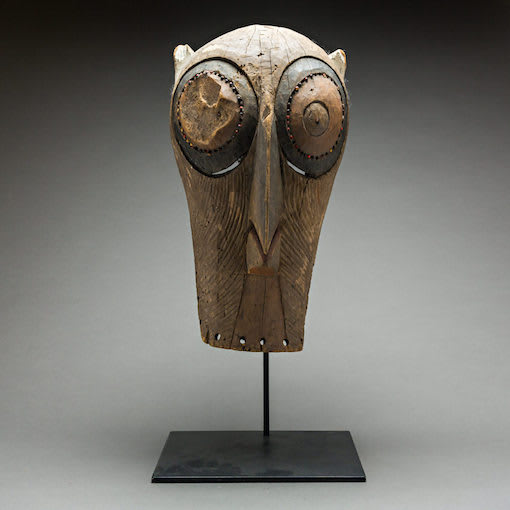Songye Kifwebe Mask, 19th Century CE - 20th Century CE
Wood
40.6 x 25.4 cm
16 x 10 in
16 x 10 in
PF.3951 (LSO)
Further images
This intimidating mask was made by the Songye group of what was once Zaire. While possessing elements of traditional Songye design, it is atypical and therefore unusual. It is based...
This intimidating mask was made by the Songye group of what was once Zaire. While possessing elements of traditional Songye design, it is atypical and therefore unusual. It is based around a tall, domed head, narrowing to a square jaw. It is dominated by massive, round eyes which are further accentuated by pigmentation of the rims, and the addition of glass beads to the circumference of the iris. The eyeholes are beneath each eye, so it could have been worn. The face is covered with linear incisions that sweep downwards and backwards, except for the top of the head – which remains smooth – and the centre of the face, which is formed into a large, parrot-like beak. This is not usual for these masks, which usually have a square or triangular mouth profile. The effect is finished off with small, white-painted ears, set well back on the head. The circumference of the piece is perforated with small holes, implying that it was worn with a textile or raffia costume. Patination is an irregular handling gloss, with some breaks and non-disfiguring damage.
The Songye people are based in the Democratic Republic of Congo (formerly Zaire). They were founded in the 16th century following an exodus from the neighbouring Shaba area, settling near to the Lualuba River. There are around 150,000 Songye divided into subgroupings that are under the governorship of a central chief known as the Yakitenge. More local governance is in the hands of chiefs known as Sultani Ya Muti. Their economy is based upon agriculture and pastoralism.
The Songye are perhaps best known for their artworks, which are both institutional and domestic/personal in nature. These include wooden figures that are usually decorated with feathers and other organic materials, and which are known as Bishimba. Large-scale and important pieces are created for use by members of the Bwadi Bwa Kifwebe, particularly including masks. The word kifwebe means “mask” in Songye, and describes long-faced creations decorated with curvilinear designs. Crested examples are male, plain-topped ones (like the current example) are female. These are brought into “conflict” during the masquerade, the male acting aggressively, the female more demurely; the significance of this seems to be that the male scares people into social conformity, while the female instills familial values. The faces of these two characters find their way onto other, secular items pertaining to the Bwadi Bwa, including staffs, shields and stools.
Research into this unusual combination of features has proved to be inconclusive. There are some examples of “rooster kifwebe” with the beak format, but these are invariably male rather than female. Furthermore, the quality of the rendering far exceeds anything in the literature. It most strongly resembles an owl, especially in terms of the large eyes and the white "ears", but there is no mention of such a tradition for the Songye. In any case, its rarity cannot be doubted. This is an impressive and powerful piece of African art.
.
The Songye people are based in the Democratic Republic of Congo (formerly Zaire). They were founded in the 16th century following an exodus from the neighbouring Shaba area, settling near to the Lualuba River. There are around 150,000 Songye divided into subgroupings that are under the governorship of a central chief known as the Yakitenge. More local governance is in the hands of chiefs known as Sultani Ya Muti. Their economy is based upon agriculture and pastoralism.
The Songye are perhaps best known for their artworks, which are both institutional and domestic/personal in nature. These include wooden figures that are usually decorated with feathers and other organic materials, and which are known as Bishimba. Large-scale and important pieces are created for use by members of the Bwadi Bwa Kifwebe, particularly including masks. The word kifwebe means “mask” in Songye, and describes long-faced creations decorated with curvilinear designs. Crested examples are male, plain-topped ones (like the current example) are female. These are brought into “conflict” during the masquerade, the male acting aggressively, the female more demurely; the significance of this seems to be that the male scares people into social conformity, while the female instills familial values. The faces of these two characters find their way onto other, secular items pertaining to the Bwadi Bwa, including staffs, shields and stools.
Research into this unusual combination of features has proved to be inconclusive. There are some examples of “rooster kifwebe” with the beak format, but these are invariably male rather than female. Furthermore, the quality of the rendering far exceeds anything in the literature. It most strongly resembles an owl, especially in terms of the large eyes and the white "ears", but there is no mention of such a tradition for the Songye. In any case, its rarity cannot be doubted. This is an impressive and powerful piece of African art.
.







